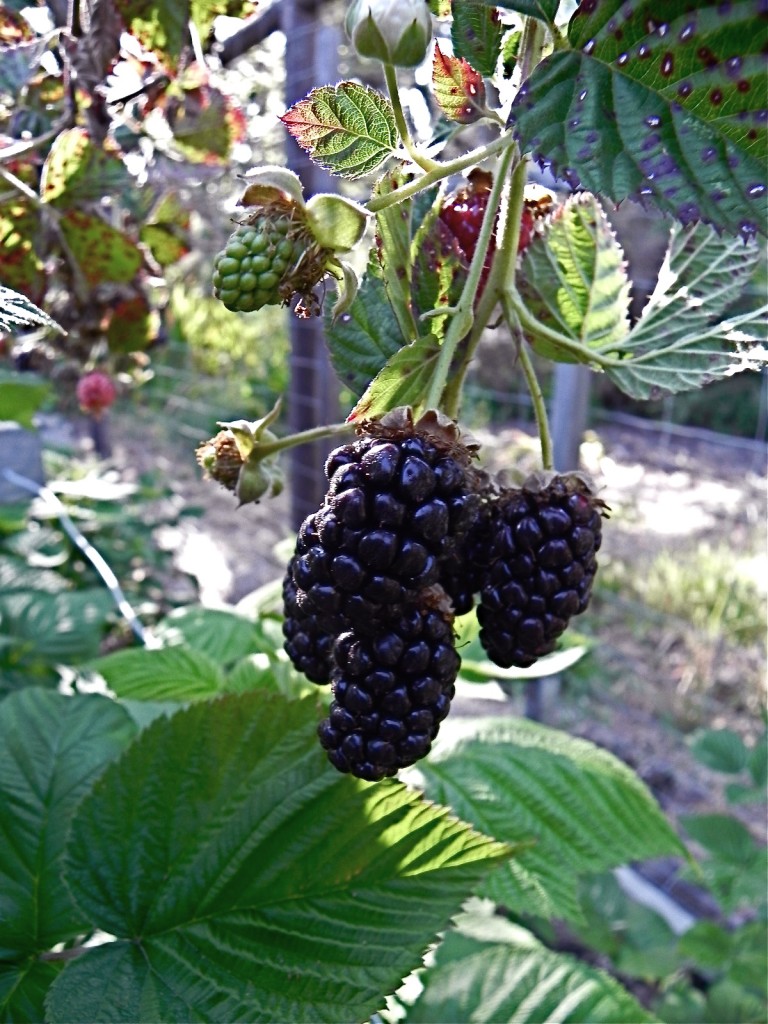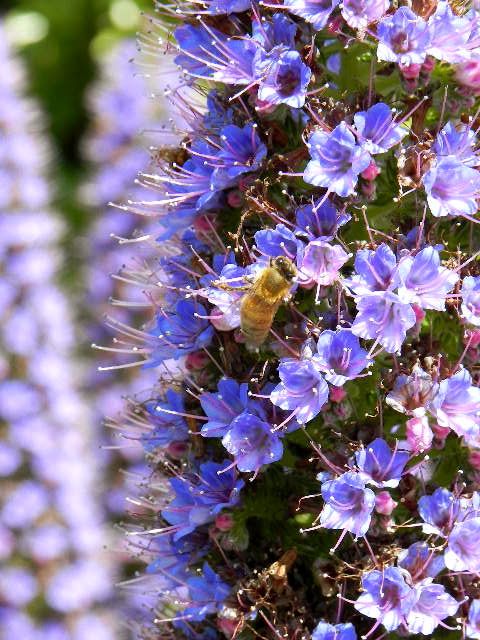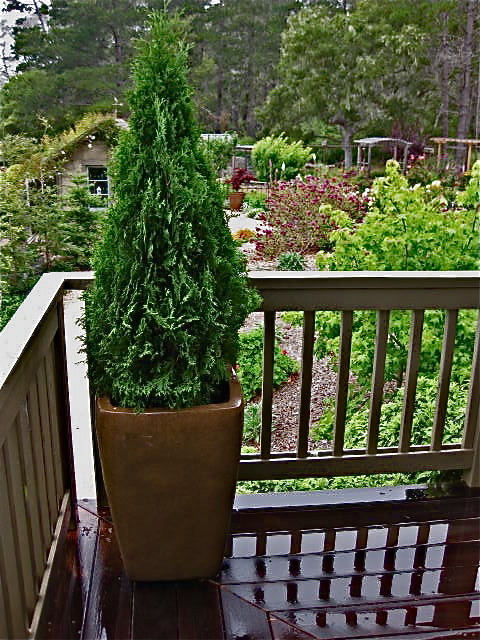
I love surprises in the garden. One of them this year has been the appearance of ollalieberries hanging from our two vines. The olallieberry is a biennial, meaning that the berries we are getting this year are from vines that grew last year along wires we strung from one support to another. The leaves appear to have black spot (a fungus common in our damp coastal climate) on them but the vines are thriving and bearing about a cup of berries a day. New stalks are growing upward and the old vines will be cut to the ground after they’ve finish producing and the new vines will take their place. I got one of these vines from a fellow gardener and I grew the second vine from a cutting.
The word “olallie” is the word for berry in the language of Native Americans of the Pacific Northwest. Olallieberry (pronounced oh-la-leh-berry) was developed in 1949 at Oregon State University by crossing a loganberry with a youngberry. Loganberries are a cross of blackberries and raspberries, while youngberries are a cross of blackberries and dewberries. Genetically, this resulted in two-thirds blackberry and one-third red raspberry. It’s physically characteristics are those of a blackberry but larger in size and somewhat sweeter. They have an intense, tart flavor, and are shiny and juicy. The olallieberry is grown mostly along the coast of California. They ripen in June and early July.
We have some reputation for olallieberries here in Cambria along the central coast. We are the home of Jon and Renee Linn, owners and creators of Linn’s More Fruit-Less Sugar Preserves and Pies. The couple owns a farm just outside town where they grow many crops, among them the olallieberries. They also own and manage bakeries, a gift shop, a coffee shop, and Linn’s Restaurant in town. You can also buy their tasty olallieberry creations at retail outlets.
If you are not inclined to “grow your own” you don’t need to deny yourself this treat. There are places where you can “pick your own olallieberries”. There are several well-known u-pick olallieberry farms that are open to the public. Crystal Bay Farm and Gizdich Ranch in Watsonville, Phipps Ranch in Pescadero and Swanton Coastways Ranch in Danvenport are a few. If you know of any others that are along the central coast and within driving distance for a day trip, please share with us. ‘Tis the season for olallieberries. Go for it!



I was just picking some Olalliberries from my garden today. This is only it’s second year so there aren’t many, but gosh are they good.
I am seeing somw worms in my olallieberries..What can I do????????????
I’m sorry you’re finding worms on your olallieberries. How disappointing. I don’t know what they are and after doing some research, it doesn’t sound like something you’d want to spray for. I have heard that when you pick berries with worm, soak the berries in a bucket of water with a tablespoon of salt and they’ll hit the road. I’ll keep looking through my garden books, Don, and let you know if I find out anything more. If you have a farm agent office with UC Cooperative Extension nearby, take a worm in, with foliage attached, and see if the Master Gardeners there can identify them.
We are still seeing worms in our olallieberry crops. Last year the crop was very sparse and had tiny tiny white worms. Isn’t there anything that we can do?
I live in Los Osos. Do you know where I can buy a vine to plant? Thanks.
The plants are easy to propagate once you have one growing. They had them for sale earlier in the year, here in Cambria, if you are willing to make the drive. They were in one gallon containers. Call first before you make the drive. See below for contact information. You might also try the Cambria Nursery here in town. They ought to do well in Los Osos. Good luck!
Linn’s Fruit Bin Farmstore
6275 Santa Rosa Creek Road, Cambria, California
Open currently Saturday and Sunday from 10am – 5pm (805) 927-8134.
Wild blackberries crossed with some red raspberries I had and have produced an amazingly productive plant that has espaliered itself along about 20 feet of 8-foot wire fencing on the west side of my garden in Fall Creek, Oregon. The fruit is cone-shaped and has been producing heavily since about July 4, with berries about 1 1/2 inches long. Still producing, although slowing down on July 15.
I am an expert jam maker and blackberry or raspberry is always low in pectin. Made a batch of this mystery berry jam last night and was amazed at the high pectin content. I usually use two boxes of pectin for about 15 jelly jars. I got 16 jars with 8 cups sugar and used just one box of pectin (low sugar SureJell is what I always use).
Might you be able to identify this mystery plant?
Wow, it sounds like you have produced your own hybrid. If I were you, I’d contact your local farm advisor(county) or the University of Oregon and see what have to say about them. I know that our local farm that grows olallieberries says that they are raspberry and blackberry, bigger than a raspberry, sweeter than a blackberry. Good luck with your new hybrid. Perhaps you can patent it and we’ll be able to seem them on the market.